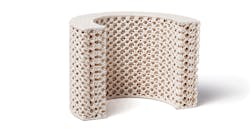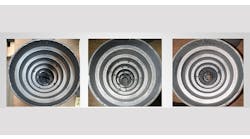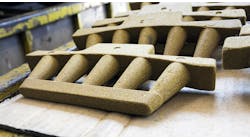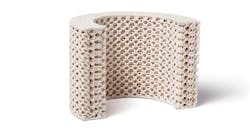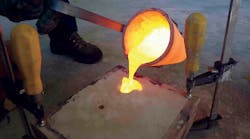Latest from Ask the Expert
A Practical Guide to Placing Chills in Large Molds
Q: We cast steel parts, and we use 100- to 150-kg "chills" to help manage the solidification process. Can you help me to understand better the principles for placing chills in large molds?
A: The importance of chills in casting production is well documented and legitimate. Nevertheless, difficulties perfecting these applications remain a source of concern. For those unfamiliar, a chill is simply a piece of metal. Its name is derived from its purpose: to encourage the solidification of pre-determined areas within a mold via heat transfer. Using chills, the metalcaster gains control over the solidification process.
This is critically important when counteracting "shrink" defects. Again, the performance of chills is not at issue; rather, ensuring proper application is most relevant. Small chills are particularly user-friendly because they are so easy to handle. This naturally reduces mold damage and chill-jostling (i.e. movement within the mold.) A chill weighing over 100 kg, however, poses greater challenges. Here, one should implement an exact process to ensure consistent success.
First, any good process should address the basics. When using chills, one should adhere to a few rules. Keep them dry and at room temperature. This may seem intuitive, yet failing to administer this simple practice could ruin many otherwise perfect castings. The concern here is introducing moisture into the casting process inadvertently. Condensation, in particular, will undoubtedly form in such an environment and defects often will result.
In addition, low temperatures counteract the curing process. Cold temperatures inhibit the curing reaction. Thus, sand adhesion is likely to be weak surrounding a cold chill, leading to poor compaction.
Rust is another factor to consider and avoid. As many know, moisture collects in rust. A popular moisture-controlling solution is to apply a refractory coating. Water-free varieties -- chromite and alcohol-based -- are available and recommended. One should shot-blast the chill(s) before placement, though, to eliminate any contaminants.
Next, ensure that your chill has been designed for the specific mold/casting. If it is not, the chill will not stay in place when the mold or core is stripped away. So, be sure your chill is properly compacted. For larger castings consider inserting your chill into a chill print. A chill print is like a core print that is added to the pattern. Once the pattern is stripped from the mold the chills are inserted into the prints using a crane.
Additionally, large chills can be submerged into the sand during molding. These may be placed directly onto the pattern or, alternatively, a layer of sand can be rammed between the pattern and the chill (i.e. blind chills.) This placement during ramming of the mold is useful when positioning chills on faces that are not horizontal. Several additional resources are available that provide more information on this topic. Please consult an ASK Chemicals representative for more details.
Two primary challenges are associated with applying large chills: lifting and placing. First, let's consider some lifting methods. When moving large chills try welding on hook points (e.g., large steel washers) with two-way or three-way chains with lifting hooks. Use a crane and carefully place the chill into the pattern. Magnets also can be helpful in this matter.
Once in place the chill must remain stable. Typically, chills reside within the drag portion of the mold, or along the vertices sidewalls. In both cases one must secure the chill using an anchor. One method - for use with a steel washer - is to run rebar through the washer and allow the sand to compact around it. This will create an anchor and will maintain the positioning of the chill.
Likewise, large chills can be held in place by welding in an anchor. This can be done using a Z-shaped rod. It will be molded into the sand, and as the sand is compacted around the chill the rod will anchor it in place.
Join the Conversation. Email Your Questions for ASK Chemicals
Share your insights, opinions, and elaborate on the questions and the experts' answer(s). You must be logged in to the website in order to post your comments.
